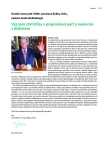Monitoring of diabetes compensation in patients treated with an insulin pump in the Czech Republic
Authors:
Zdeněk Rušavý 1; Petr Honěk 2; Ladislav Dušek 3,4; Tomáš Pavlík 3,4; Denisa Janíčková-Žďárská 5; Milan Kvapil 5
Authors‘ workplace:
Interní klinika FN a LF UK Plzeň, přednosta prof. MUDr. Martin Matějovič, Ph. D.
1; Všeobecná zdravotní pojišťovna České republiky, Praha, ředitel Ing. Zdeněk Kabátek
2; Ústav zdravotnických informací a statistiky České republiky, Praha, ředitel doc. RNDr. Ladislav Dušek, Ph. D.
3; Institut biostatistiky a analýz MU, Brno, ředitel doc. RNDr. Ladislav Dušek, Ph. D.
4; Interní klinika 2. lékařské fakulty UK a FN Motol Praha, přednosta prof. MUDr. Milan Kvapil, CSc., MBA
5
Published in:
Vnitř Lék 2015; 61(Suppl 3): 39-43
Category:
Original Contributions
Overview
Introduction:
Insulin pump treatment (IP) is one of the ways of intensive insulin therapy, designed preferentially for patients with type 1 diabetes. The price of the treatment is higher than that of the conventional basalbolus and insulin regimens using repeated insulin application with a dose selector.
Goal:
Quality assessment of IP therapy monitoring in patients with DM in a representative sample of the patient population with DM kept in the database of the General Health Insurance Company of the Czech Republic (VZP) which provided health care coverage for 63% of Czech population in 2014. Methodology: We identified all individuals in the VZP database who had a record of DM diagnosis (E10 – E16 based on ICD 10) or who had any antidiabetic therapy prescribed (ATC group A10) in the period of 2009–2013. Over the whole period of 2009–2014 there were overall n = 4 002 unique patients with DM identified in the VZP data, who were treated with IP within the assessment period. Incidence for the year 2014 (the newly treated with an insulin pump): all patients who had IP recorded in 2014 while in the preceding period of 2009–2013 they had no record of IP use. Prevalence for the year 2014 (all treated with an insulin pump): all the patients who for the period of 2010–2014 had at least once insulin pump use recorded and who did not die before 2014. Quality control parameters (HbA1c examination and consumption of glucose level test strips) for patients treated with IP were only assessed in detail for the year 2014, namely for all patients undergoing insulin pump treatment in 2014 throughout the year (i.e. from 1 January 2014 to 31 December 2014), i.e. in n = 3 189 patients in all.
Results:
In 2014 there were 247 incident patients and 3 794 prevalent patients. IP was newly introduced for almost 50% of the patients aged 20–39 years. In 2014 an average frequency of HbA1c examination equaled 3.38 per patient and 98.5% patients were examined for HbA1c at least once. An average consumption of glucose level testing strips per patient was 879 pieces.
Conclusion:
The pilot project of assessment of quality parameters for IP therapy monitoring shows that the patients treated with IP have glycated hemoglobin checked quite frequently (3.38 checkups per patient in 2014) and they measure their blood glucose 2–3 times a day on average.
Key words:
diabetes mellitus – monitoring of diabetes compensation – insulin pump – CSII
Sources
1. Andĕl M, Slabochová Z, Dryáková M et al. [General principles of intensified conventional insulin therapy of type I diabetes]. Vnitr Lek 1987; 33(6): 475–485.
2. Česká diabetologická společnost. Standardy a jiná doporučení. Doporučený postup léčby inzulínovou pumpou (continuous subcutaneous insulin infusion – CSII). Dostupné z WWW: <http://www.diab.cz/dokumenty/Standard_lecba_pumpou.pdf>. (poslední přístup 11. 10. 2015)
3. Bolli GB, Kerr D, Thomas R et al. Comparison of a multiple daily insulin injection regimen (basal oncedaily glargine plus mealtime lispro) and continuous subcutaneous insulin infusion (lispro) in type 1 diabetes: a randomized open parallel multicenter study. Diabetes Care 2009; 32(7): 1170–1176.
4. Schiffrin A, Belmonte MM. Comparison between continuous subcutaneous insulin infusion and multiple injections of insulin. A oneyear prospective study. Diabetes. 1982; 31(3): 255–264.
5. Ústav zdravotnických informací a statistiky ČR. MKN Mezinárodní statistická klasifikace nemocí a přidružených zdravotních problémů – MKN10. Dostupné z WWW: <http://www.uzis.cz/cz/mkn/index.html>. (poslední přístup 26. 9. 2015)
6. WHO Collaborating Centre for Drug Statistics Methodology. Anatomical Therapeutic Chemical (ATC) classification system. Structure and principles. Dostupné z WWW: <http://www.whocc.no/atc/structure_and_principles/>. (poslední přístup 26. 9. 2015)
7. Golden SH, Brown T, Yeh HC et al. Methods for Insulin Delivery and Glucose Monitoring: Comparative Effectiveness. Agency for Healthcare Research and Quality (US): 2012. Dostupné z WWW: <http://www.ncbi.nlm.nih.gov/books/NBK99217/>.
8. Cummins E, Royle P, Snaith A et al. Clinical effectiveness and costeffectiveness of continuous subcutaneous insulin infusion for diabetes: systematic review and economic evaluation. Health Technol Assess 2010 ; 14(11):iiiiv, xixvi, 1–181.
9. Jankovec Z, Hahn M, Grunder S et al. Analysis of continuous patient data from the Czech National Register of patients with type 1 and type 2 diabetes using insulin pump therapy. Diabetes Res Clin Pract 2010; 87(2): 219–223.
Labels
Diabetology Endocrinology Internal medicineArticle was published in
Internal Medicine

2015 Issue Suppl 3
Most read in this issue
- Incidence of amputations among patients with diabetes mellitus in the Czech Republic from 2010 to 2014
- The mortality of patients with diabetes mellitus using oral antidiabetic drugs in the Czech Republic decreased over the decade of 2003–2013 and came closer to the population average
- Monitoring of diabetes compensation in patients treated with an insulin pump in the Czech Republic
- Clinical and economic benefits of the new antidiabetic drugs in the Czech Republic
